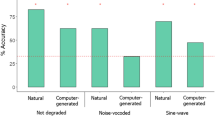Abstract
The present study examined the effectiveness of one configuration of automatic speech recognition (ASR) software and hardware with a child sample of 36 three-year-olds and a comparison sample of 20 adults. Subjects used a speaker-dependent, template-based system to play a simple “Sesame Street” naming game. Results indicated that while the system performed well with adults, it was much less effective with children. An analysis of the children's performances indicates that children's speech is more variable, in both volume and content, than that of adults. The ASR system responded ineffectively to this variability, resulting in inferior performance. Specific behaviors and their effects on the ASR system are identified, and possible system modifications that address these behaviors are noted.
Similar content being viewed by others
References
Char, C. (1990, April).Touch, click, or jump? The relative merits of different input devices for use by young children. Paper presented at the Annual Meeting of the American Educational Research Association, Boston.
Gordon, P. A., & Luper, H. L. (1989). Speech disfluencies in nonstutterers: Syntactic complexity and production task effects.Journal of Fluency Disorders, 14, 429–443.
Grover, S. C. (1986). A field study of the use of cognitive-developmental principles in microcomputer design for young children.Journal of Educational Research, 79, 325–332.
Haelsig, P. C., & Madison, C. L. (1986). A study of phonological processes exhibited by 3-, 4-, and 5-year-old children.Language, Speech, and Hearing Services in the Schools, 17(2), 107–114.
Hoko, J. (1986, Nov–Dec). Alternatives to keyboarding.Tech Trends, 23–24.
Hubbard, C. P., & Yairi, E. (1988). Clustering of disfluencies in the speech of stuttering and nonstuttering preschool children.Journal of Speech and Hearing Research, 31, 228–233.
Mack, M., & Lieberman, P. (1985). Acoustic analysis of words produced by a child from 46 to 149 weeks.Journal of Child Language, 12, 527–550.
Madlin, N. (1986, April). Conversant computers.Management Review, 75, 59–60.
Nittrover, S., Studdert-Kennedy, M., & McGowan, R. S. (1989). The emergence of phonetic segments: Evidence from the spectral structure of fricative-vowel syllables spoken by children and adults.Journal of Speech and Hearing Research, 32, 120–132.
Razavi, S., Medoff, L., & Strommen, E. (1991, April).“Do I push this button?”: Three year olds' use of the Nintendo controller. Paper presented at the annual meeting of the Eastern Psychological Association, New York.
Revelle, G. L., & Strommen, E. F. (1990). The effects of practice and input device used on young children's computer control.Journal of Computing in Childhood Education, 2(1), 33–41.
Revelle, G., Strommen, E., & Offerman, S. (1990).Cursor and device differences in children's computer control. Manuscript submitted for publication.
Rollins, A. (1985). Speech recognition and manner of speaking in noise and in quiet. In L. Borman & B. Curtis (Eds.),CHI '85 Conference Proceedings (pp. 197–199). Reading, MA: Addison-Wesley.
Rollins, A., Constantine, B., Baker, S. (1983). Speech recognition at two field sites. In A. Janda (Ed.),CHI '83 Conference Proceedings (pp. 267–273). Reading, MA: Addison-Wesley.
Schachter, S., Christenfeld, N., Ravina, B., & Bilous, F. (1991). Speech disfluency and the structure of knowledge.Journal of Personality and Social Psychology, 60, 362–267.
Simpson, C. A., McCauley, M. E., Roland, E. F., Rutch, J. C., & Willeges, B. H. (1985). System design for speech recognition and generation.Human Factors, 27(2), 115–141.
Strommen, E. (1990).Consistency and variability in children's naming of Muppet characters. Unpublished manuscript, Children's Television Workshop.
Wijnen, F. (1988). Spontaneous word fragmentation in children: Evidence for the syllable as a unit of speech production.Journal of Phonetics, 16, 187–202.
Author information
Authors and Affiliations
Rights and permissions
About this article
Cite this article
Strommen, E.F., Frome, F.S. Talking back to big bird: Preschool users and a simple speech recognition system. ETR&D 41, 5–16 (1993). https://doi.org/10.1007/BF02297088
Issue Date:
DOI: https://doi.org/10.1007/BF02297088




